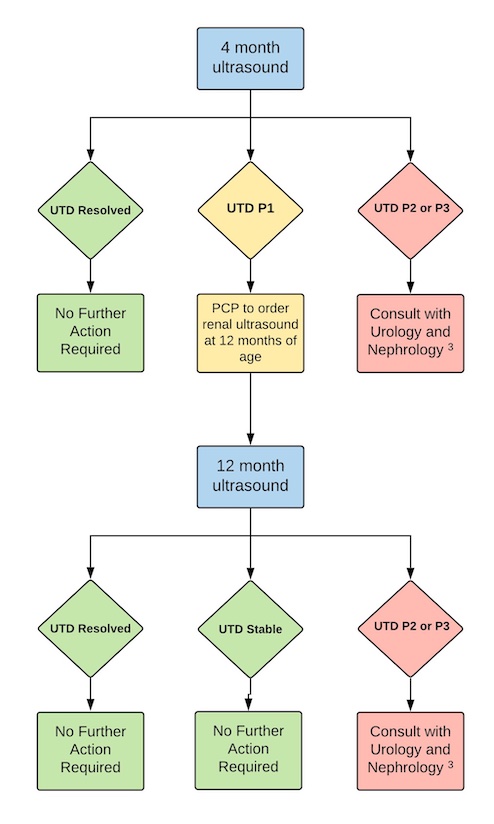Outpatient Urinary Tract Dilation Care Process Guideline
This 2020 University of Utah and Primary Children’s Outpatient Services care guideline advises what next steps should be taken by outpatient primary care clinicians to manage otherwise healthy infants and young children with a diagnosis of urinary tract dilation (UTD) confirmed after birth with normal kidney function and without urinary tract infections (UTIs) or hypertension. See Prenatal Urinary Tract Dilation Care Process Guideline for management of newborns with suspected hydronephrosis/UTD based on fetal imaging.
Key Points
- Consult Pediatric Nephrology for abnormal renal parenchyma, hypoplastic kidney(s), or solitary kidney.
- If an infant’s 4-month renal ultrasound (aka retroperitoneal ultrasound or renal/bladder ultrasound (RBUS)) demonstrates UTD A2-3, the primary care clinician should confer with Pediatric Nephrology and Pediatric Urology to determine additional workup and management strategies, including but not limited to labs, voiding cystourethrogram (VCUG), and/or prophylactic antibiotics.
- If an infant’s 4-month renal ultrasound demonstrates UTD A1, it should be repeated at 12 months to ensure it is stable or resolved.
- Worsening UTD requires consultation with specialists.
- All infants and children with UTD should have blood pressure measured at all well-child checks.
Outpatient Urinary Tract Dilation Care Process Guideline


Related Portal Content
Prenatal Urinary Tract Dilation Care Process Guidelinel
Guidelines & Algorithms
For Professionals
Hydronephrosis/Urinary Tract Dilation (Children's Hospital of Philadelphia)
An explanation of causes, symptoms, testing, diagnosis, and treatment for hydronephrosis.
Authors & Reviewers
| Authors: | Aarti Vala, MD |
| Caitlin G Peterson, DO | |
| Contributing Author: | Jennifer Goldman, MD, MRP, FAAP |
| Reviewers: | M Chad Wallis, MD |
| Anthony J Schaeffer, MD, MPH, FAAP |


 Get Help in New Mexico
Get Help in New Mexico